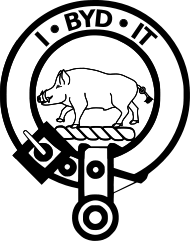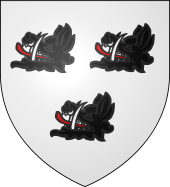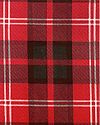- Clan Nesbitt
-
Clan Nesbitt or Nisbet Crest badge 
Crest: A boar passant Sable, armed Argent and langued Gules Motto: I BYD IT Slogan: "A Nisbet" Profile Region Borders District Berwickshire Plant badge Oak Chief

Mark Nesbitt of that Ilk Chief of Clan Nesbitt Historic seat Nisbet House Clan branches Cairnhill, Carfin, Craigintinnie, Dalzell, Dean, Dirleton, Greenholm, Mersington, Northfield Clan Nesbitt (or Clan Nisbet) is a Scottish clan recognised by the Lord Lyon King of Arms and first mentioned in a Scottish charter of 1139. It is a lowland family centred in Berwickshire, East Lothian, Edinburgh and Ayrshire, with a significant historical presence in Northumberland and Durham. The clan has a chief, Mark Nesbitt of that Ilk, and active clan associations in the British Isles, North America and Australasia.
Contents
History
Origins of the clan
The surname of the Berwickshire line derives from the hamlets of East Nisbet and West Nisbet, Berwickshire. Interestingly, until the 16th century, the lands are most often spelt Nesbit, which has a claim to be the original spelling. Some bearers of Nisbet/Nesbitt (and variant) names may originate from the village of Nisbet in Roxburghshire.
The lowland family of Nesbitt or Nisbet has its roots in the county of Berwickshire, in the Scottish Borders. Like the families of Home and Swinton, its descent can be traced from Gospatric, Earl of Northumbria (d. 1073). In 1139 King David I confirmed a charter (now in the archives of Durham Cathedral) granting the lands of Nisbet to Aldan de Nisbet, the founder of the line of Nisbet of Nisbet (i.e. Nisbet of that Ilk).
In the 12th century, castles were built by the Nisbet family at West Nisbet, two miles south of the town of Duns, and at East Nisbet, now known as Allanbank, southeast of Duns on the Blackadder Water. The castle at East Nisbet has long gone, but at West Nisbet the original pele tower was incorporated into the east end of a magnificent new fortified mansion house, built by Sir Alexander Nisbet of that Ilk (c. 1580-1660) in the 1630s. Nisbet House still stands, with an 18th century tower (with fine interior plasterwork) added to its west end. The house is in private ownership.
DNA results
An active DNA genealogy project is co-ordinated by Tom Nesbitt. Testing of about 75 individuals (by 2009) has identified three major and distinct DNA groups[1]:
DNA Group One. The group borne by Mark Nesbitt, the Clan Chief. Several members in the US match his DNA code
DNA Group Two. This very large group appears to be from Northern Ireland. In the early 18th century, their descendants immigrated to New Jersey, Pennsylvania, and Maryland along with thousands of Scots-Irish settlers.
DNA Group Three. This large group appears to be connected to both Scottish and English NN families moving outward from the Borders. Also connected are the descendants of Alexander Nisbet born 1731 at sea on route to America, who settled in North Carolina. Also includes the descendants of the Greenholm line from end of 1500's
17th century & Civil War
The family of Nisbet of that Ilk lost its estates in the Wars of the Three Kingdoms and the English Civil War. Chief Sir Alexander Nisbet of that Ilk was a fervent supporter of Charles I, but was to lose three sons, as well as his newly built tower house. The family motto, "I byd it" (I endure it) was all too appropriate. The eldest son, Sir Philip Nisbet, was executed in Glasgow after the Battle of Philiphaugh; Col. Robert Nisbet was captured after fighting in support of James Graham, 1st Marquess of Montrose and executed at Edinburgh in 1650.
Major Alexander Nisbet was killed at the Siege of York in 1644. His youngest son, Adam Nisbet, had one son, Alexander Nisbet (1657–1725), the well-known author of A System of Heraldry. Nisbet "The Herald" died unmarried, and is commemorated by a memorial in Greyfriars Kirk, Edinburgh.
In 1679 Capt. John Nisbet, of Ayrshire, helped win the Battle of Drumclog when John Graham, 1st Viscount of Dundee, also known as Graham of Claverhouse was defeated and a number of his men put to death. However, later the Covenanters, for whom Capt. John Nisbet fought, were defeated by the English in Lanarkshire and Capt. John Nisbet was compelled to hide. He was betrayed, and captured by Lieut. Nisbet and executed in Edinburgh in 1685.
18th to 19th centuries
The family's male line continued through Sir Alexander's brother, the Reverend Philip Nisbet, who had moved south to York and become Rector of St. Martin's Micklegate. The Reverend Philip was a fervent Covenanter and supporter of the Parliamentarian cause. The future history of the family was to centre on York, then London, with the spelling changing to Nesbitt in the 1830s.
Distinguished members of the clan include E. Nesbit, the children's writer (The Railway Children), Alexander Nisbet, heraldic writer, Murdoch Nisbet of Hardhill, who translated the New Testament into Scots, Mary Nisbet (Lady Elgin), Robert Chancellor Nesbitt, M.P. and historian, and Frances Nisbet of Carfin, who married Lord Nelson.
Clan branches
Related branches of the Nisbet family became established at Dean in Edinburgh, Dirleton in East Lothian, Greenholm in Ayrshire, and Carfin and Cairnhill in Renfrewshire. In the 17th century, many Nisbets went to Ireland and, often via Ireland, to North America.
The surname in England
The origins of the family in England are unclear. Nesbit is an ancient place name in northern England[2]. The manor of Nesbit Hall, Hesleden, County Durham, is recorded as of 1350. The township of Nesbit, north of Doddington, Northumberland, is recorded by 1242, and was held by the de Vesci family. The township of Nesbit in the parish of Hart, ward of Easington, County Durham, is recorded since 1311. In all three cases there is no evidence of use of Nesbit as a surname, although Philip Nisbet, ancestor of the current clan chief, came to Easington as rector in 1644.
The Manor of Nesbit two miles south of Stamfordham, Northumberland is first mentioned in 1213. In 1240 part of the land was held by Walter de Nesbit; in 1256 a Walter Nesbit and a Thomas, son of Adam Nesbit, held land from the Priory of Hexham. These names are certainly reminiscent of those carried by the Berwickshire family, but disappear from the locality by the 16th century. There was a pele tower at Nesbit, held by Sir Thomas Grey but gone by 1540.
Further evidence for an early group of the family in England is from the life of Thomas Nesbitt, a Durham monk who became Prior of Coldingham (1447–1456), and whose uncle was a Hull wine-merchant.
Clan tartan
According to the Scottish Tartans Society the Nesbett tartan is identical to the Mackintosh, and similar to the Dunbar sett, which both appear in the Vestiarium Scoticum. There is however no historical link between the Nisbetts and Clan Mackintosh to explain why the tartan is based upon that Mackintoshes.[3] The Vestiarium was a Victorian era forgery, first published in 1842 by the Sobieski Stuarts. Even though it has since been proven forgery, the Vestiarium is still the basis of many of today's clan tartans.
Clan chief
The clan was chiefless for four centuries following the loss of the Nesbitt lands during the Civil War. In 1994 the Lord Lyon recognised Robert Anthony Ellis Nesbitt as Chief of the Name and Arms of Nesbitt (or Nisbet). After his death in 2000, his son Mark Nesbitt (1961-) became Chief.
Clan profile
- Arms: Argent three boars heads erased Sable, armed Argent and langued Gules.
- Crest: A boar passant Sable, armed Argent and langued Gules
- Motto: I byde it ("I endure it")
- Plant badge: Oak
Clan castles / ancestral lands
- Nisbet Castle, Berwickshire
- Nisbet House, Nisbet, Berwickshire
- Dirleton Castle, purchased in 1663 by lawyer John Nisbet when it was already a ruin, Nisbet built nearby Archerfield as his country residence.
Variant spellings
Nesbitt, Nesbit, Nisbet, Nisbett, Nisbeth (Sweden and Denmark), Naisbitt
Clan society
The Nesbitt/Nisbet Society was founded in 1980 by Prof. John A. Nesbitt, of Iowa. The British Isles branch was founded in 1983, the North American branch in 1985, and the Australian branch in 1986. Each branch also serves neighbouring regions, and all three work closely together. Total membership is 400+ families. Each branch organises gatherings, those in the British Isles usually held in locations with historic family associations; those in North America in association with one of the well-known Highland Games. Membership is open to all, whether descended from or related to N/Ns, or interested in the family.
Note
- ^ Nesbitt 2007
- ^ Mills 1998
- ^ "Tartan - Nesbett". Scottish Tartans World Register (scottish-tartans-world-register.com). http://www.scottish-tartans-world-register.com/tartan.aspx?record=2115. Retrieved 2008-09-12.; see also: "Tartan - MacKintosh". Scottish Tartans World Register (scottish-tartans-world-register.com). http://www.scottish-tartans-world-register.com/tartan.aspx?record=1476. Retrieved 2008-09-12.
References
- A.D. Mills (1998). English Place Names. OUP.
- Nesbitt, Robert Chancellor (1994). Nisbet of that Ilk. Phillimore. ISBN 0-85033-929-4.
- Nesbitt, Tom (February 2007). "DNA testing: the gene in genealogy. NN Society DNA results: 2003-2006.". Nesbitt Nisbet Society. North American News 40: 1–20.
External links
- Nesbitt/Nisbet Society (United Kingdom)
- Nesbitt/Nisbet Society (Australasia)
- Nesbitt/Nisbet Society (North America)
- Nesbitt & Nisbett Heraldry
Scottish clans Clans with chiefs Agnew · Anstruther · Arbuthnott · Arthur · Bannerman · Barclay · Borthwick · Boyd · Boyle · Brodie · Broun · Bruce · Buchan · Burnett · Cameron · Campbell · Carmichael · Carnegie · Cathcart · Charteris · Chattan · Chisholm · Cochrane · Colquhoun · Colville · Cranstoun · Crichton · Cumming · Darroch · Davidson · Dewar · Drummond · Dunbar · Dundas · Durie · Elliot · Elphinstone · Erskine · Farquharson · Fergusson · Forbes · Forsyth · Fraser · Fraser of Lovat · Gayre · Gordon · Graham · Grant · Gregor · Grierson · Guthrie · Haig · Haldane · Hamilton · Hannay · Hay · Henderson · Home · Hope · Hunter · Irvine · Jardine · Johnstone · Keith · Kennedy · Kerr · Kincaid · Lamont · Leask · Lennox · Leslie · Lindsay · Lockhart · Lumsden · Lyon · MacAlister · MacBain · MacDonald · Macdonald of Clanranald · MacDonald of Keppoch · Macdonald of Sleat · MacDonell of Glengarry · MacDougall · Macdowall · MacIntyre · Mackay · Mackenzie · Mackinnon · Mackintosh · Maclachlan · Maclaine of Lochbuie · MacLaren · MacLea (Livingstone) · Maclean · MacLennan · MacLeod · MacLeod of Lewis · MacMillan · Macnab · Macnaghten · MacNeacail · MacNeil · Macpherson · MacTavish · MacThomas · Maitland · Makgill · Malcolm (MacCallum) · Mar · Marjoribanks · Matheson · Menzies · Moffat · Moncreiffe · Montgomery · Morrison · Munro · Murray · Napier · Nesbitt · Nicolson · Ogilvy · Oliphant · Primrose · Ramsay · Rattray · Riddell · Robertson · Rollo · Rose · Ross · Ruthven · Sandilands · Scott · Scrymgeour · Sempill · Shaw · Sinclair · Skene · Spens · Stirling · Strange · Stuart of Bute · Sutherland · Swinton · Trotter · Urquhart · Wallace · Wedderburn · Wemyss · Wood ·
Armigerous clans Abercromby · Abernethy · Adair · Adam · Aikenhead · Ainslie · Aiton · Allardice · Anderson · Armstrong · Arnott · Auchinleck · Baillie · Baird · Balfour · Bannatyne · Baxter · Bell · Belshes · Bethune · Beveridge · Binning · Bissett · Blackadder · Blackstock · Blair · Blane · Blyth · Boswell · Brisbane · Buchanan · Butter · Byres · Cairns · Calder · Caldwell · Callender · Campbell of Breadalbane · Campbell of Cawdor · Carruthers · Cheyne · Chalmers · Clelland · Clephane · Cockburn · Congilton · Craig · Crawford · Crosbie · Cunningham · Dalmahoy · Dalrymple · Dalzell · Dennistoun · Don · Douglas · Duncan · Dunlop · Edmonstone · Fairlie · Falconer · Fenton · Fleming · Fletcher · Forrester · Fotheringham · Fullarton · Galbraith · Galloway · Gardyne · Gartshore · Ged · Gibsone · Gladstains · Glas · Glen · Glendinning · Gray · Gunn · Haliburton · Halkerston · Halket · Hepburn · Heron · Herries · Hogg · Hopkirk · Horsburgh · Houston · Hutton · Inglis · Innes · Kelly · Kinloch · Kinnaird · Kinnear · Kinninmont · Kirkcaldy · Kirkpatrick · Laing · Lammie · Langlands · Learmonth · Little · Logan · Logie · Lundin · Lyle · MacAulay · Macbrayne · MacDuff · MacEwen · MacFarlane · Macfie · Macgillivray · MacInnes · MacIver · Mackie · MacLellan · Macquarrie · Macqueen · Macrae · Masterton · Maule · Maxton · Maxwell · McCorquodale · McCulloch · McKerrell · Meldrum · Melville · Mercer · Middleton · Moncur · Monteith · Monypenny · Mouat · Moubray · Mow · Muir · Murray of Atholl · Nairn · Nevoy · Newlands · Newton · Norvel · Ochterlony · Orrock · Paisley · Paterson · Pennycook · Pentland · Peter · Pitblado · Pitcairn · Pollock · Polwarth · Porterfield · Preston · Pringle · Purves · Rait · Ralston · Renton · Roberton · Rossie · Russell · Rutherford · Schaw · Seton · Skirving · Somerville · Spalding · Spottiswood · Stewart · Stewart of Appin · Strachan · Straiton · Strange · Sydserf · Symmers · Tailyour · Tait · Tennant · Troup · Turnbull · Tweedie · Udny · Vans · Walkinshaw · Wardlaw · Watson · Wauchope · Weir · Whitefoord · Whitelaw · Wishart · Young
Culture and society Scotland · Clan chief · Septs · Clan badge · Clan crest · Clan battles · Tartan · Bagpipes · Clearances · Kilt · Manrent · The Highlands · Battle of Culloden · Highland games · Border Reivers · Scottish heraldry · Scottish surnames
Categories:- Scottish clans
Wikimedia Foundation. 2010.

